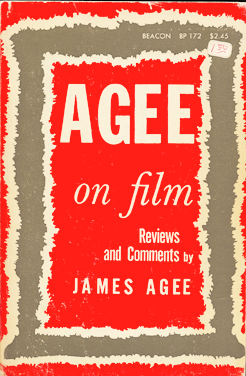I think that everyone watches movies, reads books and listens to songs and thinks at times, “I love that.” Likewise with looking at pieces of art or striking architectural works, or even tasting food in a great restaurant. Whatever our particular threshold of superiority, we know it when we experience it.
Occasionally the sensation goes beyond admiration to motivation. Sometimes I’ve thought not just “I love that” but “I want to do that.”
I’ve read things that jarred me so much I had to put the book down. These moments have arrived without warning, when I wasn’t mining for gold. I suppose there’s a case to be made that the narrative is done a disservice when the reader stops to admire the words, as if we were to stand before David and discuss only Michelangelo’s hammer and chisel. But for me it’s been worth the detour from a story to examine the material and tools.
One of the handful of works that ignited in me a drive to write was a piece of post-WWII film criticism. Here is what James Agee wrote in 1948 in The Nation:
John Ford’s The Fugitive is a solidly pro-Catholic picture about a priest, a creeping Jesus. My feelings about the Catholic church are, to put it mildly, more mixed than Mr. Ford’s; I doubt that Jesus ever crept, and I am sickened when I watch others creep in His name; I dislike allegory and symbolism which are imposed on and denature reality as deeply as I love both when they bloom from and exalt reality; and romantic photography is the kind I care for least. Over all I think The Fugitive is a bad work of art, tacky, unreal, and pretentious. Yet I think almost as highly of it as [Jean Vigo’s Zero de Conduite, Chaplin’s Monsieur Verdoux, Vittorio da Sica’s Shoeshine, Luigi Zampa’s To Live in Peace, André Malraux’s Man’s Hope], because I have seldom seen in a moving picture such grandeur and sobriety of ambition, such continuous intensity of treatment, or such frequent achievement of what was obviously worked for, however distasteful or misguided I think it.
I knew the movie in question. For a John Ford picture it was uncharacteristically subtle. I thought the story dragged but had admired it, largely for the nuanced photographic work of Gabriel Figueroa, whose sophisticated black-and-white images helped to convey Henry Fonda’s priest-character’s resolve and resignation.
Agee’s short description stunned me with its beauty and would have even if I hadn’t seen the film. I sought and found more of his work. Most of his magazine criticism was short. He would cover five or six movies at a time, and only occasionally did he devote more than a paragraph to one of them.
Another moment of inspiration came in Thomas Wolfe’s Look Homeward, Angel. Behold:
At 18 Valley Street, the red shack-porch, slime-scummed with a greasy salve of yellow negroid mud, quaked rottenly.
I reproduce that sentence from memory because it has held a place there for decades.
And this, from Steinbeck’s To a God Unknown:
He had been upon a star, and now the hills rushed back and robbed him of his aloneness and of his naked thinking. His arms and hands felt heavy and dead, hanging like weights on thick cords from the shoulders that were tired of supporting them.
Oh, how I’ve loved being moved by these words! They’re like wise old friends to me, friends I can go to for comfort. And they always prompt the question, “I wonder if I can do that.”
